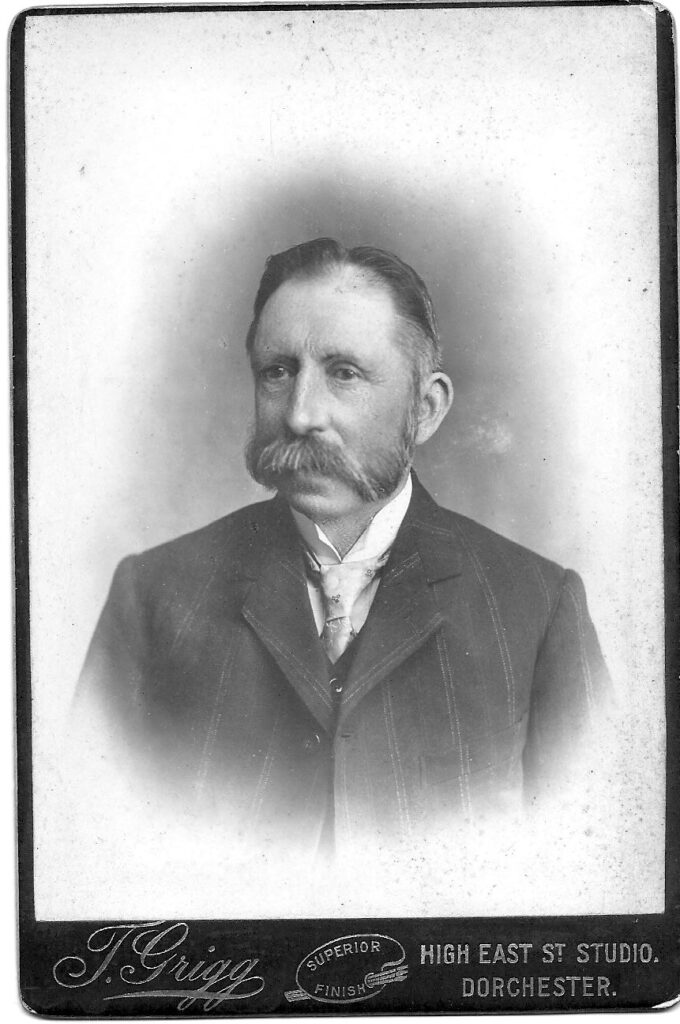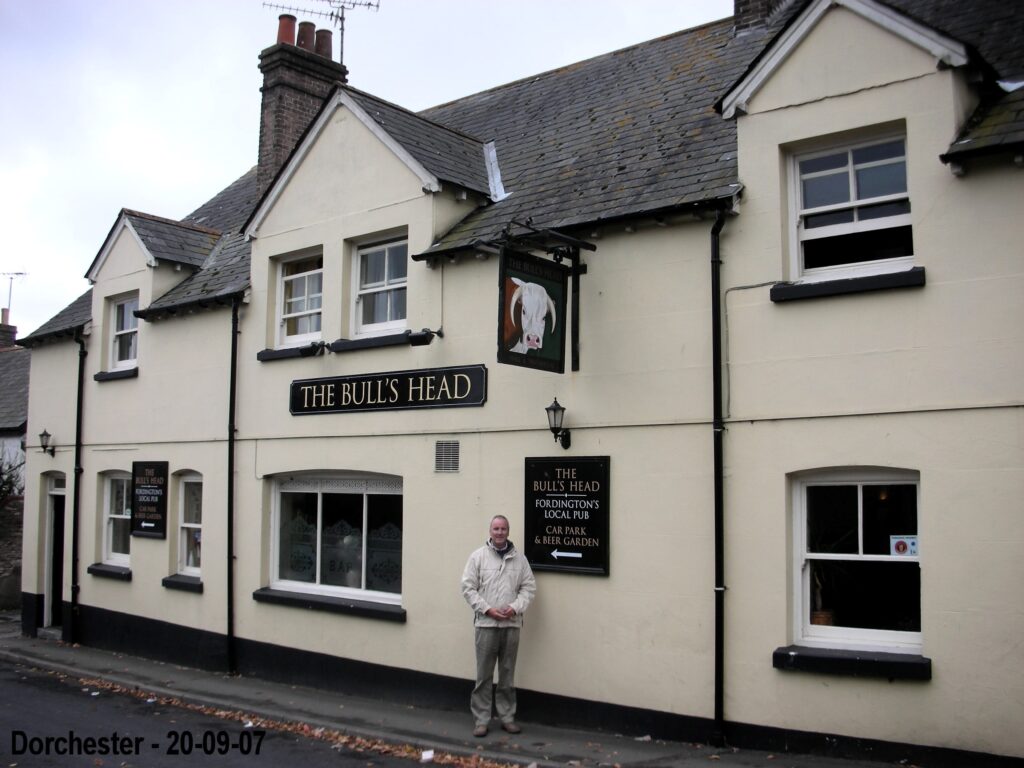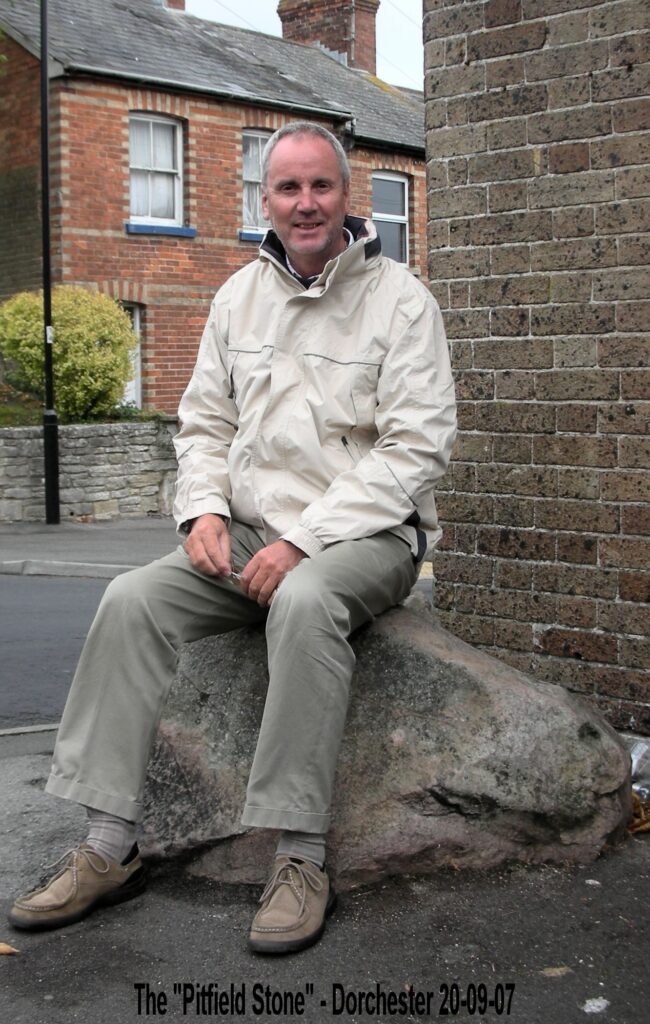At Dorset History Centre, we are keen to encourage guest blogs from our readers detailing the research and work they are undertaking. Michael Pitfield has written us this second post (you can read the first here if you missed it) explaining where fifty years of genealogical research have led him…
—
For some 50 years, my distant cousin Hugh Pitfield and I have been researching our Pitfield genealogy. We have amassed a huge amount of data and many detailed profiles of family members and the relationships. Hugh has published the genealogy in a (free) indexed file of some 160 pages that can be consulted online and/or downloaded at www.pitfield-family.co.uk. The Dorset History Centre has a copy.
In my previous blog ‘The Pitfields of Dorset’ I described the family in general. From 1700, the largest grouping of the Pitfield began to develop in Fordington, Dorchester.
The ‘founding father’ of the Fordington Pitfields was Sebastian Pitfield (1632-1702), the son of Robert of Donhead St. Mary, and grandson of Sebastian the sea captain mentioned in the last blog.
Sebastian married Christian Meadon (1641-1715) and they lived in the two parishes of Chaldon Herring and Broadmayne, before moving to Fordington sometime between 1685 and 1695. Sebastian may well have decided to settle in the parish because his uncle, Renaldo Knapton, was already living there and the two of them had a number of business dealings in the late 1600s.
Sebastian only had two children who outlived him and only his son Charles Pitfield (1666-1743) married and had children. Knapton’s continued to be prominent in Dorchester, Renaldo’s son Thomas and his grandson (another Thomas) were Governors of the town gaol and had homes in Fordington.
Sebastian Pitfield’s will survives and shows him to be a man of some wealth. His son Charles was Churchwarden of Fordington three times – 1726, 1730 and 1731, and his accounts survive.
Early generations of the Pitfield family in Fordington prospered and are described as ‘yeoman’. They invariably had large families, as was common at the time, and thus the Pitfield family in Fordington grew very substantially over the 18th and 19th centuries. For example, Joseph Pitfield of West Knighton was wealthy, described as being a ‘yeoman farmer’ holding land in Bere Regis. In his will he left a large estate divided between his son and the children of his brother Sebastian of Fordington.
By the mid/late 1700s, many of the menfolk had found work only as agricultural labourers and some continued as such well into the 19th century. Others had developed skills or professions such as masonry, tailoring or hairdressing.
In 1835 Fordington was incorporated into the enlarged Borough of Dorchester and it had the dubious distinction of being the poorest and most overcrowded of the four Dorchester parishes, containing nearly half the Borough population, with 2,986 people listed in the 1851 census, 35 of whom were Pitfields (with another 6 Pitfields listed elsewhere in Dorchester). A Board of Health report of 1848 described conditions there:
“.. in High Fordington, for want of means of cleansing, typhus fever has not been absent for the last three years, and in lower Fordington there is a crowded and pauper population dwelling in the midst of filth.”
A more graphic account was given by the Reverend Henry Moule, vicar of Fordington, in a letter published by the Dorset County Chronicle, at the time of the cholera epidemic of 1854:
At the East end of Dorchester, then, and within a space that can scarcely exceed five acres, about 1,100 persons are congregated in a set of dwellings, many of which are of the most wretched description, and utterly destitute of the ordinary conveniences of life. This space consists of two great divisions, Mill Street, on the one side of a Mill Pond, and Holloway Row, together with Cuckold Row and Standfast, on the other side. – In Mill Street, the floors of the houses lie considerably below the highest elevation of the pond, and some of them even below its bed. The other division consists of two, and in one part of it, of three rows of cottages, rising one above the other, from the bank of the Mill Pond, on the other side of a chalk hill. In Holloway Row, about twenty of the cottages have a small patch of ground, about 18 feet square, and a pathway and lane in front of them. They have also a little space hollowed out of the hill behind them. But, with these exceptions, scarcely a cottage in this division (and the same may be said of many in Mill Street) has a single inch of ground beyond that on which it stands. Their filth is consequently cast either into the open and wretched drain in the street, or into the Mill Pond, from which, moreover, the people draw most of their water for washing, and sometimes, even for culinary purposes, “the conveniences” of more than half these 1,100 people empty themselves together with the filth from the County Goal, and of some portion of the other three Parishes of Dorchester. The population, with few exceptions, consists of mechanics, labourers, and paupers from this and many other parishes. Vice, in its worst forms, abounds amongst them.
This chronic overcrowding was caused by the building of tenements in the early 1800’s, as an outlet for the poorer inhabitants of the increasing population of Dorchester, on the only piece of freehold land available in the area. The land was owned by the Duchy of Cornwall which, since the death of Prince Albert, had become poorly managed. In these circumstances several Pitfield families lived in Mill Street, Holloway Row, Cuckolds Row and elsewhere in Fordington, throughout the nineteenth century. Their fortunes had changed from the time of their yeoman ancestors and those who still had farming connections were employed as agricultural labourers. Others worked in the iron foundry or were general labourers or mason’s labourers, whilst their womenfolk were engaged in domestic service or took in laundry to supplement the family income. Illegitimacy rates are high in such areas, including amongst the Pitfields.
The conditions in Fordington were ripe for the spread of cholera, which was introduced by the intake of unwelcome strangers to Dorchester in 1854. After the departure of the garrison to the Crimean war, the Dorchester Barracks were left empty, and it was proposed that they should be used to house convicts from the overcrowded Millbank penitentiary in London. Despite the concern and protests of the Mayor and Aldermen of Dorchester regarding the risk of the spread of cholera (which was rife in the London prison) 700 prisoners were transferred to Dorchester on August 15th. On August 24th Rev. Moule found that two women in Holloway Row had been employed to wash for the convicts. Moule pleaded in vain with the Mayor to have the laundry removed, and within a few days a child living 60 yards from one of the women’s cottages was taken ill and died. In the weeks that followed there were at least 30 more deaths from cholera, with many more taken ill. Although no members of the Pitfield family were amongst those who died it is probable that they were affected to some extent by the outbreak.
A local Board of Health had been set up in Dorchester in 1853, and after the cholera epidemic it implemented street cleaning and drew up plans for deep sewerage and a new water supply. Due to the efforts of the Board, and the campaigning of the Rev. and Mrs. Moule, conditions in Fordington gradually improved during the second half of the nineteenth century.
—

George Pitfield (1815-1874) prospered as publican of the Union Arms in Cuckold’s Row, Fordington. His son George (1844-1917) became publican of the Bull’s Head and was succeeded by his son George John (1871-1947). The elder George was a keen pigeon breeder and won many prizes and cups at national events such as the Crystal Palace Show in 1896.

George John was unsuccessful, family lore says he drank the profits. He moved his family to Uxbridge in Middlesex in 1906 and set up small business as a barber. He had been an apprentice to his uncle Edwin earlier in his life. The Bulls Head, still exists as does the building that was the Union Arms.

Edwin Pitfield (1855-1922) was a successful master hairdresser with premises in High West Street (they still exist). He was barber to Thomas Hardy and described seeing the first Mrs Hardy freewheeling her bicycle down the street with her skirts flapping behind her.
Another anecdote relates to the huge stone on the corner of Fordington Square opposite the church. This stone is still there but in former times it was highly polished. This was because all the lads of the area, including very many Pitfield boys used to gather there in summer evenings and sit on the stone. This had the effect of smoothing and polishing it, and it became known as ‘The Pitfield Stone’.

—
The coming of the railways brought further opportunities for work including for several Pitfields. Resulting mobility meant that families could look further afield for homes and work, thus the Fordington Pitfields began to spread out to other parts of the country with many being drawn to Southampton, London and the South East. One of these emigrants from Dorset was William Pitfield, a crew member on the RMS Titanic, he did not survive the sinking.
Others made their future even further afield and emigrated (or, in some cases, were transported) to the New World and the antipodes.
Many of those who left have been traced and have been connected to the family tree.
In common with most families, the Pitfields lost sons in the First World War. One such was very unusual – an early airman, Henry Pitfield, Air Mechanic 1st Class, in the Royal Navy Air Services on HMS President. He died in 1918 at the age of 19, son of Henry and Kate Pitfield who were by this time living in Wimborne. He features in the War Memorial Book at Wimborne Minster.
The Fordington parish records contain more Pitfield entries than in any of the other Dorset parishes, due to several couples having ten or more children. Sebastian Pitfield (1757-1815) had ten children and 28 Pitfield grandchildren christened at Fordington, although a fairly high child mortality rate meant that a number did not survive. In 1871 there were 43 Pitfields listed in the census for Fordington. During the next ten years there was a marked reduction in this number, with many female Pitfields marrying and other members of the family moving out of the parish. The last christening of a Pitfield at Fordington was in 1916, although some members of the family were buried there as late as the 1940’s and there are still Pitfields living in nearby Dorchester today.
—
Do you have any Pitfields in your family tree? Let us know in the comments below!


My Roper family was joined to the Pitfields of Symondsbury by the marriage in 1832 of Jane Symonds Roper (1805-1877) to John Pitfield (1800-1854). a leading ‘Yeoman’ of the Parish residing at Higher Eype, farming some 1100 acres of arable, pasture and flax fields, and employing more than fifty men and two dozen women and boys. They had six sons, and after John’s early death Jane carried on the farm aided by three of their sons the eldest of whom (John) would go on to enjoy a reputation far beyond Dorset as a breeder of Dorset Horn Sheep and Devon Cattle.
By all accounts the Pitfields were well respected employers as evidenced by the effusive accounts in the ‘Bridport News’ of the day of Harvest festivities they hosted and their contribution to the life of Symondsbury Parish. The youngest son George Roper Pitfield, apparently had a particularly fine singing voice! The farm would remain in his hands until he sold up in 1901 and moved with his wife Lilian (nee Flower) to nearby Chideock.
Thank you for this Paul.
Have you looked at the Genealogy referred to in my blog. There is a lot about the relationships between the Pitfields the Ropers and others in Symondsbury. See Table 8.1.1.1 et seq.
My Great Grandmother was Mary Jane Pitfield who married George Russell and moved to Portsmouth after they married. She is descended from Sebastian Pitfield and Phoebe Parsons.
I’d love to chat to relatives as I know very little about her and the family as she passed away two days after my Mum was born in 1936.
Thank you Jacqui,
Have you looked at the genealogy referred to in my blog above?
Mary Jane and George Russell are there – see Table 10.1.1.1.1.
Their ancestry – and thus yours goes back to the 1500s.
Best wishes
Michael
My father was Frederick Leslie Pitfield and I was born in Dorchester in October 1946. My grandad was Frederick Sebastian Pitfield born in the 1870s.
Can anyone shed any light on the hellard family who lived in mill street my mother told me she had two sisters . She was put in a convent in Bristol and found her father many years later
Hi Richard, thanks for your message. If you’d like to drop us an email – archives@dorsetcouncil.gov.uk – one of the team can take a look into this for you.
Poole_r@sky . Com my grandfathers name was Percy Charles hellard my mother eventually had contact with him in the sixties she found him through the Salvation Army he did not contact her until then
Thanks Richard – your query has been passed onto one of the team here who will be in touch in due course.
Thank you very much